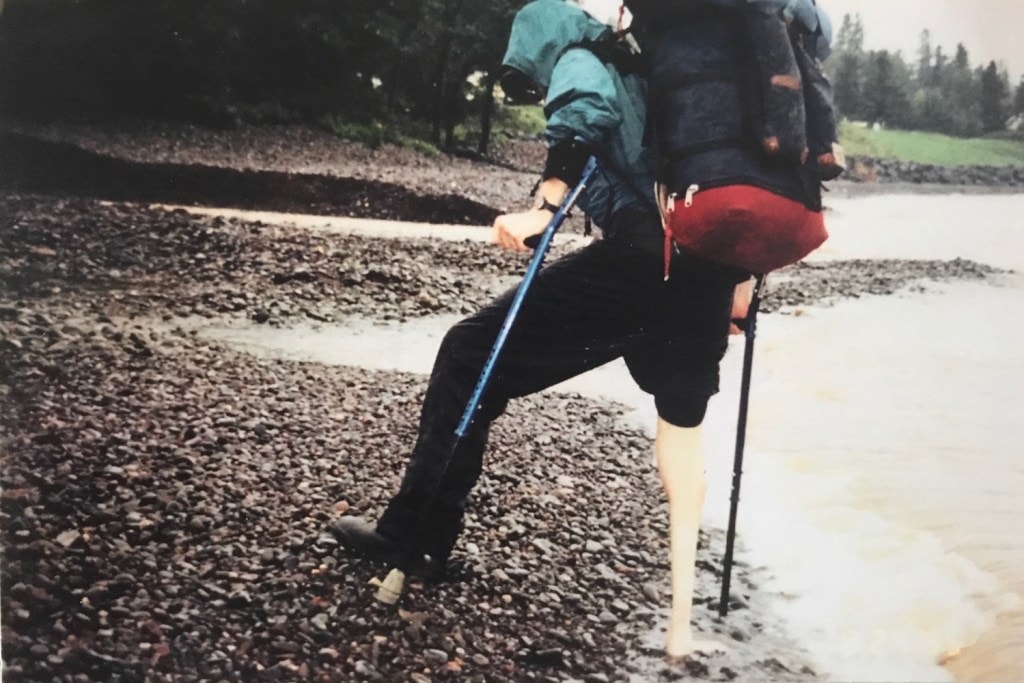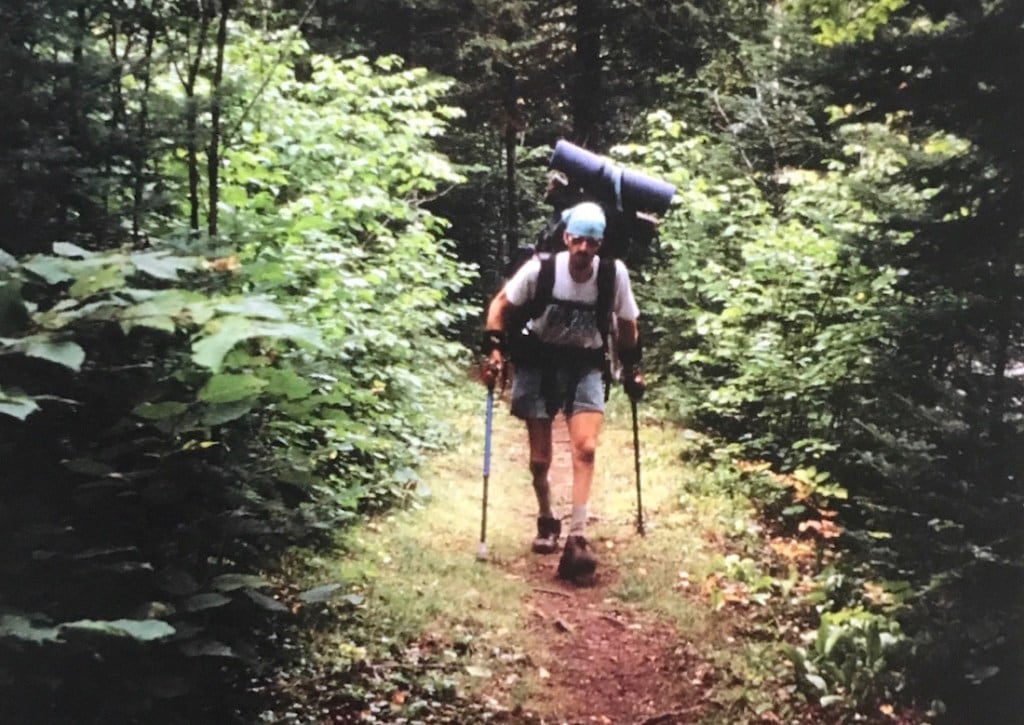In 1995, Paul Hlina became the first person to complete Minnesota’s Superior Hiking Trail—and he did it on crutches. Two decades later, locals are still working hard to perfect and maintain the trail for the hundreds of thru-hikers who now travel it each year.
The Superior Hiking Trail (SHT) stretches for over 300 miles from just north of Duluth, Minnesota, to the Canadian border, loosely following Lake Superior. Because the majority of the rocky SHT is along a ridgeline, it’s packed full of panoramic views of the lake below and waterfalls galore. Besides the vistas, the next best thing about the trail is its blend of accessibility with technical challenge. Thanks to its northern location, the SHT catches the first changes of fall well before the rest of the state, offering hikers flashes of yellow and red leaves as early as August, complete with eagles soaring overhead. Some will catch glimpses of moose, while even the most novice fisherpeople looking to catch their dinner will be able to pull trout, walleye and pike out of the many streams along the route between April and October.
The first section of the SHT opened in July of 1987, which, as a Lake Superior Magazine article reports, was celebrated by the chopping of a log rather than the cutting of a ribbon. Thanks to support from the Legislative Commission on Minnesota Resources, construction occurred steadily between 1987 and 1993. After 1993, one or two new sections opened almost annually until the completion of the full 300 contiguous miles in 2013.
This summer, though, held more updates. Besides the installment of a fiberglass bridge over the Red River near Minnesota’s eastern border, the Superior Hiking Trail Association (SHTA)—the nonprofit that’s been managing the trail since its inception—is working on rerouting a 3.5-mile section of the trail at the request of the landowner whose property the section currently passes through. The reroute takes place in Gooseberry Falls State Park near the beginning of the trail. (Until its completion, hikers can still pass through thanks to a temporary solution that includes ski trails and a brief road hike.)
While the SHTA doesn’t track how many people use the trail, it’s estimated that there are now several hundred thru-hikers each year. According to the nonprofit, most thru-hikers now undertake what’s called a flip-flop hike, starting at the southern end and hiking to Grand Marais. From there, they take a shuttle to the northern terminus of the trail and hike back down to Grand Marais to finish, eliminating complicated pickup logistics at the much more remote northern section.
“I’m a disabled botanist who gets out to places that I’m sure humans haven’t seen in 10,000 years.”
Before the SHT averaged several hundred thru-hikers per year, Paul Hlina, now 61 years old, became the first person to complete the trail—and he did so on crutches. “I was hurt in a car accident in 1979. I’d love to say I was skydiving or rescuing someone,” Hlina said. “I broke only one bone in my body—only one bone ever, in fact—and it happened to be a vertebra that cut my spinal cord just a little bit,” which ultimately left Hlina partially paralyzed from the waist down.
After the accident, Hlina spent nine months in bed, unsure if he would ever walk again. He did, thanks to months of intensive therapy, but has required the assistance of crutches ever since—something that he’s never let slow him down. “Focus on what you can still do. That’s been the guidepost for me,” said Hlina. “I do believe in making your dreams come true. I’m a disabled botanist who gets out to places that I’m sure humans haven’t seen in 10,000 years.”

Hlina kicking off his adventure at Lake Superior in Two Harbors, Minnesota. Because Terry Fox, the runner who inspired his journey, started with his foot in the Atlantic Ocean, Hlina would symbolically repeat Fox’s gesture with the lake.
One of his dreams was thru-hiking the SHT, inspired in part by a hiker north of the border. “When I was first hurt, there was a Canadian by the name of Terry Fox, an amputee runner,” Hlina explains. Fox set out to run across his country to raise money for cancer research, the disease that took his right leg when he was 18. He began what he called his Marathon of Hope in 1980 while Hlina was still bedridden.
Fox never finished his journey. He was forced to stop running near Thunder Bay, Ontario, when his cancer came back, this time in his lungs. Fox died in June of 1981. “The Pigeon River”—the terminus of the SHT along the Canadian border—“is pretty close to Thunder Bay, so my journey was a testament to him and his family,” Hlina said.
Before the hike, Hlina trained for a year and a half. “This is what I did, every Monday through Friday at work: I went over to a steep boat landing in a park across the street from my work on my lunch break. I walked up and down that boat landing for an hour carrying a 30-pound pack,” Hlina said.
With the assistance of his specially made spring-loaded crutches, he was also running on the weekends. “I was a runner before I got hurt and I thought it would be really effective if I ran in Grandma’s Half Marathon,” Hlina explains. He took part in the annual, Duluth-based race that year and clocked in at just under his goal time of 3.5 hours.
When Hlina’s leg brace broke on the sixth day, around 60 miles into his hike, the company that crafted it not only made him a new brace but met him out on the trail to properly fit it.
The half marathon was in June and Hlina used to it drum up coverage for his hike in August. He studied maps of the trail to plan out his adventure, allotting for 8 to 10 miles per day. On the SHT, Hlina started out with a 60-pound pack and relied on the same boots he still sports to this day: “Vasque Sundowners. They’re the only shoe that has ever worked for me,” he said.
To account for safety, someone met Hlina out on the trail each night to make sure he made it to where he was trying to go, most often Ken Oeklers and Tricia Ryan, both of the trail association at the time. Hlina relied on dehydrated food to fuel up. And, as a vegetarian, he recalls a lot of “bean and rice type dishes; dehydrated vegetables and that kind of thing.”
Over the course of 21 days, he traversed the entirety of the then 200-mile trail, conquering a variety of challenges throughout. When Hlina’s leg brace broke on the sixth day, around 60 miles into his hike, “the brace people,” as Hlina refers to them, from Northern Orthotics and Prosthetics in Duluth, not only crafted him a new brace but met him out on the trail to properly fit it.

“Looking lopsided, but strong,” Hlina said of this picture of him, taken mid-way through his SHT hike.
On day 14, Hlina was roughly 120 miles into his journey when he started to feel a sharp pain in his right leg, which led him to think that the bone was breaking. After attempting to call for help on a phone that the Red Cross gave him and receiving nothing but static, Hlina veered off course to find help. He found a hunting shack where he planned to stay for a day or two until his leg improved. It eventually became clear that he’d need more than rest, so Hlina filled up a day pack and set out for the small town of Grand Marais on the shore of Lake Superior. “I got to Lake Agnes,” Hlina recalled, still roughly 20 miles from town, when “all of the sudden I hear my name in the distance. I thought I must have been hallucinating, but it was Ken. I hadn’t shown up [to my target destination] and he found me.”
Hlina saw a doctor in Grand Marais, marking the most difficult part of his journey. “The pain got really bad and there was a lot of doubt,” he said. “But when they said it was just an overuse injury, I reduced the weight of my pack down to 30 pounds and kept going. I knew then that I would finish.”
It’s Hlina’s wife, Judy, who he gives all the credit to when he looks back. One of the first things he said about his trip was “my wonderful wife, Judy, doesn’t get enough credit for everything she did while I was gone. We were a young couple and we had a four-year-old and a four-month-old.” It’s Judy who made his journey possible in the first place by managing a home with two young children on her own for 21 days, in addition to meeting him twice on the trail to help him resupply.
On the last day, Hlina’s family, supporters and a variety of reporters met him at the end to complete the last part of his journey with him. In addition to recalling how his four-year-old hammed it up with the cameras and news crews, Hlina remembers this: “A reporter asked ‘Now that you’ve accomplished this, what do you want to do next?’ and I said, ‘It’s right in front of you—be a good father and husband.’”
Hlina used the press coverage and general awareness surrounding his adventure to raise funds for fellow outdoor enthusiasts and the trail itself, eventually pulling together $16,000. “$6,000 of it went to trail maintenance and $10,000 went to scholarships for people with disabilities as well as able-bodied people—I like to call them TAB’s (temporarily able-bodied) because everyone’s body gives out eventually—to attend the Outward Bound-like courses that Wilderness Inquiry offers,” said Hlina.

Hlina and his son (Ben), wife (Judy) and a reporter at the start of the hike
After his hike, Hlina spent a month in a wheelchair because what the doctor in Grand Marais thought was an overuse injury was actually a stress fracture. “The reason my bone felt like it was breaking was because it actually was,” Hlina, who was happy to return to his crutches once again, recalled with a chuckle.
When Hlina thinks back to his 200-mile trek nearly two decades ago, his only regret is not seeing a moose. “It was during the last few days and I was camping in a gravel pit, a really ugly part of the trail. A reporter came out and he was so excited because he was from Florida and had just seen three moose on his way in,” he said. “I had been there 19 days and hadn’t seen any—and he already saw three!”
Today, Hlina is a recently retired 61-year-old botanist, happily living on a plot of land that he’s populated with a variety of native plants that he studies and cares for. Though he still gets around just fine, some days, he works so hard that he has to literally crawl back to his truck, fueled by a love for and fascination with plants and nature. In his retirement, he hopes to volunteer and to help illustrate the effects of climate change through the migration of certain plants to the North. “My goal is to live like 20 more years,” said Hlina. “I’m definitely at peace. My spiritual journey through life goes through nature.”
